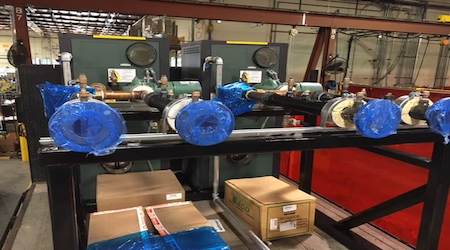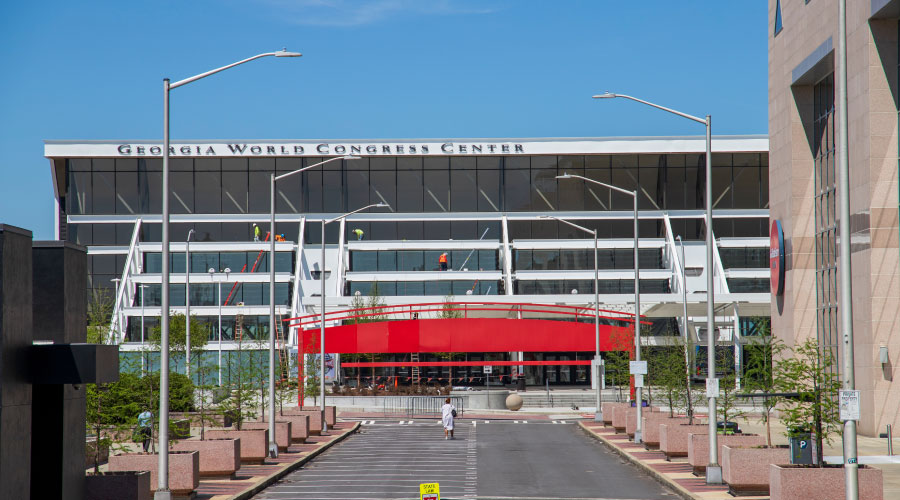 Framing boilers in the shop before installation. Envise
Framing boilers in the shop before installation. Envise Funding Improvements and Upgrades with Energy Savings at City College of San Francisco
New boilers and wireless-pneuamtic thermostats resulted in an immediate improvement in occupant comfort.
Energy consumption’s impact on operating costs is just one reason today’s building owners and operators are being forced to set goals for reduction. With sustainability top of mind, the savviest building owners and operators are working with strategic partners to understand how to package savings realized from short-term energy efficiency measures with other deferred-maintenance type work that is critical to functional buildings.
Batmale Hall, for example, is a landmark building for City College of San Francisco (CCSF), housing 129 classrooms and more than 1,600 workstations on the CCSF Ocean Avenue main campus. Constructed between 1977 and 1978, the building’s original heating, ventilation and air conditioning (HVAC) systems remained in place, resulting in an outdated and obsolete pneumatically operated HVAC that could not keep pace with the growing demand for improved comfort. For many years, occupants complained about stale air, and temperatures being too hot and too cold, depending on proximity to single-paned windows on the building’s perimeter. Simultaneously, energy was needlessly wasted as heating and cooling systems competed constantly to satisfy the conflicting demands.
In 2012, California voters passed Proposition 39. Under Prop 39, some $550 million became available to California schools to fund energy efficiency and clean energy projects. Of that, $40 million was earmarked for the state’s community colleges, specifically for a series of five one-year appropriations for projects that met specific criteria described in guidelines published by the California Energy Commission. With CCSF requiring vital upgrades, the college was in a position to take advantage of this funding.
Once Prop 39 passed, the college’s Superintendent for Buildings and Grounds immediately began to compile the data at Batmale Hall required to apply for Year One’s funding. In collaboration with its partners, the college created a list of targeted building systems and a budget scope that would ultimately be used to secure $1.1 million of the available Year One funds under Prop 39. A solution for Batmale Hall was designed, which engineering consultants leveraged to put the building through an exhaustive mechanical evaluation and assessment. This action controlled and collected pages of data on the uneven heating and cooling zones throughout the building’s seven stories. Performance requirements were prepared in addition to a scope of work for the project specifications and requirements necessary to satisfy the Savings-to-Investment ratio of 1.05 called for in the Prop 39 guidelines. The project scope was to produce improved air balancing, upgrades to the existing chiller and boiler systems, and a major overhaul of the pneumatic control system for the concrete building; including replacement of more than 119 pneumatic thermostats with new wireless thermostats that convert the existing pneumatic control of space temperatures into Direct Digital Control (DDC).
Tapping into Experts for “Heavy Lifting”
Working closely with the college and engineering consultant, explicit specification language was crafted that provided an edge, and offered the additional benefit of Web-based integration with multiple building systems. The relationship and close collaboration with decision-makers during the entire project development phase also enabled the whole project team to be acutely aware of the budget and where the pricing needed to be in order to win a competitive bid.
With the Prop 39 funds secured, the project was initiated with upgrades to structural support. The team also began implementation of a system that was sensitive to electronic controls central to every zone on each floor, including faculty offices and student learning spaces. The rehabilitation of miles of pneumatic tubing that suffered neglect and degradation over the years, mostly in occupied spaces, was one challenge. In addition to these repairs and replacements of the pneumatic compressed air system, scheduling of the heavier work posed another significant challenge. Positioning and operating crane lifts for the new HVAC units and replacing outside air louvers on the building’s built-up air handler system required coordinated mobilizations during school holidays and semester breaks, when critical equipment associated with the upgrades could be shut down.
With the new boilers and wireless-pneumatic thermostats installed, Batmale Hall occupants immediately felt improvements in comfort. In addition, CCSF had new, high efficiency boilers and a chiller with ample capacity to keep those occupants satisfied without wasting energy. Because San Francisco’s cool climate makes it one of the top three cities in the world to operate economizers on an air handler, the addition of new louvers on Batmale Hall’s air handler allowed the college to take advantage of using free outside air to cool the building’s spaces throughout the year. All of this was optimized with a robust Web-based tool to monitor and control the operation and energy consumption of the new units. As a result, today CCSF can be sure they are running at peak efficiency and that the energy savings promised on the Prop 39 application will be delivered.
Jeff Ginn is the northern California sales manager for Envise, a national building management systems. He can be reached at jginn@enviseco.com.
Related Topics:












